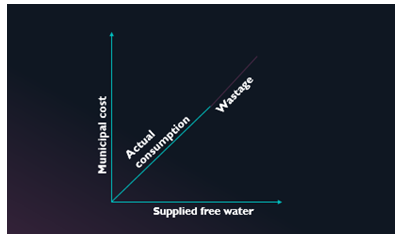Public Policy Case Solution
Many of the failures of free water policy implementation are because of the cost recovery issues. The full recovery above 6 kiloliter level is critical for the financial viability of the municipal, ongoing implementation of free water and the viability of the entire water sector.
In addition to this, the full cost of the water services must be recovered fully, for the purpose of making sure that the investment is sustainable.In the water value chain, the summary of tariff or charge provides strong foundation to ensure that the full cost of the water services is being recovered. The kinds of tariffs to recover the cost of water services, are as follows:
- Water resource development charge.
- Water discharge charge.
- Retail water tariff and sanitation charges.
- Waste water and bulk water tariff.
The graph shows that the number of households are increasing from year 2006 to 2016, with the 1.55 percent annual growth rate, thus demanding more water sources which in turn tends to increase the cost of water services. Because of the direct relationship between the number of households and the cost of water services; the issue of cost recovery is of high importance to ensure the sustainability of the free water policy.((ANC), 2003).
Wastage of freely supplied water
Under the free water policy, almost 7.5 million people have an access to water through communal taps which are being offered by the municipalities in South Africa. The supply of the water free of charge to people with low household income is of high importance, but it could result in the wastage of water because of the potential indifference in the non-paying customers. Thus, it could lead towards the loss of the financial resources as well as the municipal water. In order to effectively deal with the issue; there is a need for effective strategy that must reward the low-income communities to reduce the wastage of the water.
Policy issues and problems
The resolving of issues-related to the policy was initiated in 2001, in South Africa,in order to overcome the financial hurdles to provide water to the low-income communities and to increase the access to the water because the lower access to water had continued to expose the lives of people to severe health hazards. The issues related to the free water policy are discussed below:
Requirement of funding for infrastructure: access to water
The provision of water is cited as main function of the municipality, which is directly lacked in the department-because of the lack of sufficient water infrastructure in various areas. Along with sustaining the investment program of water sources; the municipal should be focused on making sure of the ongoing and an effective maintenance and operations of the water infrastructure. The root cause of the program’s failure is the failure to plan for maintenance of water sources infrastructure in the systematic way, which in turn tends to create a massive drag in meeting the goal target for sanitation and water.
Recover cost of free water services
The-effectiveness of the free water policy could be enhanced by achieving cost recovery as well as fulfilling the right to have an access to the water services. The full cost of providing water services includes economic cost as well as the environmental externalizations related to the ecosystem maintenance and public health. The principle of managing water services as a social and economic product entails that the full cost of water services should be the objective of all water uses. The water resource development charge, waste water and bulk water tariffs, sanitation charges and retail water tariffs and water discharge charge are some forms of tariffs settings which could be used as means the water services’ cost recovery.
Reduce resource wastage
It is pertinent to note that currently, about 7.5 million (13%) of the entire population of South Africa has an access to water through public standpipes and 14 million (25%) of the entire population of South Africa lives close or below to the line of food poverty of 384 USD / annum per person (STATSSA, 2017). In South Africa, the wastage of water from communal taps most likely cause the required overuse of the water resources in the nation that is highly prone to the water stress.(Konstantin W.Scheihing, 2020).
Set of recommendations for each policy issue.
One area of inequity between people is the access to the basic amount of clean or drinkable water. The efficient allocation of water resource-sis one of the key concerns in South Africa. South Africa is not well endowed with abundant fresh water supplies and there is a limited budget for the basic infrastructure services. The country is now challenged with ensuring the efficient allocation of the water. The initiation of the free water policy was based on providing water to the citizens free of charge.
In order to effectively deal with the issue of financing the infrastructure projects; there is a requirement of establishing a financial system which should support the operational and physical planning of the water services. One of the elements of the financial system’s establishment is the development of subsidy and tariff policies that would most likely support the long term financial stability of the local government. The creation of the solutions for decent living by delivering municipal services on consistent basis of the right standard and quality, includes the delivery of and planning for amenities and infrastructure, upkeep and maintenance including the requisite budgeting and ensuring that there would be no failures in the provision of the services. The government should take the responsibility of perfect financing and planning of the infrastructure. The development of the infrastructure involves the construction of the water plants, infrastructure facilities, distribution pipes and so forth. The monitoring and planning of the infrastructure development involves different stakeholders and government being the primary participant during the process of procurement. Other participants would be suppliers, consulting engineers, contractors and sub-contractors.
In addition to this, the success in the recovery of the cost of water services vary widely with the percentage of households that tend to consume through paying regularly, range from near 100 to 0. One of the most successful method to encourage the recovery of the water service cost is the use of the service restrictions to penalize the non-payment. Furthermore, there are various methods that could be used to deal with the issue of an increasing cost of water services, such as: progressive tariffs, offer convenient facilities for payment in order to improve the cost recovery. Furthermore, the effective method of the cost recovery is that the consumers who tend to use more than the allocation of the free basic water, would be billed for what they consume. Additionally, the water allocation could be enhanced by promoting the efficient use of water, innovation and investment with due regards for the social implications, improving the knowledge of water consumption and sustainability limits and improving the monitoring of water uses and resources, ecosystem health, watershed conditions to better assess the future water availability and make more robust decisions.(Officials, OECD Council Recommendation on Water, 2016)....................
This is just a sample partial case solution. Please place the order on the website to order your own originally done case solution.














